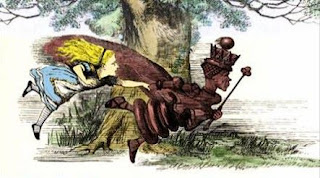"Well, in our country," said Alice, still panting a little, "you'd generally get to somewhere else — if you run very fast for a long time, as we've been doing."
"A slow sort of country!" said the Queen. "Now, here, you see, it takes all the running you can do, to keep in the same place. If you want to get somewhere else, you must run at least twice as fast as that!" [1]
While all the cool cats were slogging trail miles in MA, I pounded the Freeport roads at the Great Osprey 10K. It was a cool morning, some wind, but overall a beautiful day for a race. The front line was thin. My goal was very low 6:00s on the uphill miles, and very low 5:50s on the down hill miles. Mile one (uphill) was a perfect 6:01. After probably 1/2 mile, I found myself in 5th place. While the front pack was very thin, it still felt like a (spread out) pack since there's just not much cumulative spread in the first mile. I think running with everyone made the pace feel easy. Mile two (uphill) was 6:15. Ouch. By the mile one split, I was running alone and the pack feeling disappeared. Mile two felt hard especially for the pace. Mile three (downhill) was 6:02. This was supposed to be low 5:50s. There went my low 37s. Mile four (uphill) was 6:07. Somewhat soon after the mile 4 marker I caught 4th place. We ran together for all of mile 5. I started to pass him at least five times and each time he stayed just in front. I wasn't going to argue with his pulling me. At one point he did drop behind me for a bit, but then passed me back. Mile 5 (downhill) was 6:01. Finally, somewhere after the mile 5 marker, I passed him for good. Racing, and not just time-trialing, was fun, especially since I came out on top. Mile 6 (uphill) was 6:17. Ouch squared! Last 0.2 at 5:38 pace. 4th place. 2nd Master. About 3:30 behind than the 1st master. Ouch cubed!
Results were frustrating. 38:03. My goal was to go well under 37:30 and even reach for 37. I don't think I'm delusional. My workouts have been going very well, unlike last summer. My mileage has been dropping and I feel pretty fresh. I did an easier than normal workout Tuesday and some short snappy segments during my runs Thursday and Friday. I'm working harder but not getting faster. Apparently I haven't a clue how to train. Big taper, moderate taper, no taper? Doesn't matter. Pre-season, mid-season, late-season? Doesn't matter. I ran LL Bean in 38:06, 3 seconds slower. That was a hot, humid July day. And a hillier course. Both are USATF certified. And I hadn't even started, you know, race training like 5K-10K pace intervals. After stalking some race times this afternoon, I realized that the Osprey course is a lot slower than I had thought. The guy that I raced in mile 5 had been doing consistant 17:4x - 17:5x at Back Cove 5K during late summer and he torched me by by almost a minute at B2B - so at least I have that to cling to.
That's my penultimate race for 2012. I have NE XC champs in 2 weeks. Then I'm hanging up the shoes for a long winter's sleep. I've been training with my retrocalcaneal bursitis since March 6 and running on it since April 8. It really needs a rest.































